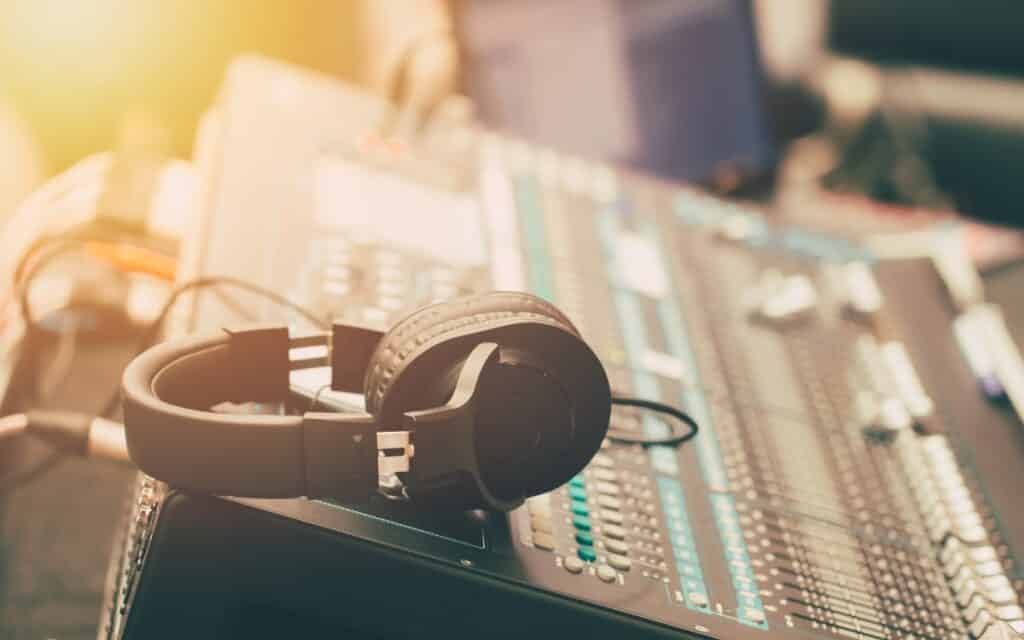Monitor headphones, sometimes called studio headphones, are built to reproduce sound as close to the studio recording as possible. You may have seen them used in recording studios for monitoring and mixing, but they are just as useful for the casual listener and audiophile.
You know that feeling when you’re listening to an old track through a pair of good quality earphones, and get stumped when you discover an instrument that you never knew was in the song? Monitor headphones are guaranteed to give you that feeling over and over, even if you’re just listening to the music instead of making it.
There is no hard and fast rule stating that monitor headphones are helpful only for people in the audio industry. If you’re reading this and wondering whether you should get a pair of headphones for your digital piano, gaming, or binge-watching your favorite show, you’ve come to the right place.
This article will thoroughly answer the question what are monitor headphones, decode some technical jargon, and help you decide whether they’re right for you.
Post Contents
What Makes Monitor Headphones Special?

A pair of monitor headphones might seem like a fancier, more pretentious pair of overpriced headphones. But there’s actually a lot of structural differences that separate them from your average headphones, and the listening experience between the two will be very different!
Monitor Headphones Have A Flat And Wide Frequency Response
Frequency response refers to the range of bass, mids, and treble. The human ear can listen within a range of 20 to 20,000 Hz. The lowest number, 20Hz, is the lowest sound your headphones can create, and 20,000Hz is the highest. Some headphones may be able to play a broader range of frequencies (even beyond 40 kHz!), while some may have a slightly narrower range.
An extremely wide frequency range means that your monitor headphones can accurately reproduce an entire range of frequencies, even beyond human hearing. A flat frequency response would mean that your headphones do not highlight any particular set of frequencies (bass or treble) and can play all frequencies at the same average volume.
This flat and wide frequency response makes sure that you listen to all layers of the audio without any “coloring”, reproducing studio-quality recording as much as possible. You’ll find your monitor headphones suitable for all audio. They won’t run into trouble playing clear high frequencies or rich low frequencies, providing an ‘even’ listening experience with high-quality sound.
Monitor Headphones Don’t Boost Bass Levels In The Audio
If you’re an audio nerd, plot a frequency vs. volume graph for any good non-monitor headphones – your graph is likely to create a U-shape. This is because regular headphones try to make the music seem colorful and lively to the listener by boosting bass and treble levels, and recessing the mids.
Monitor headphones never boost bass levels, which has to do with their flat frequency response. They’re built to maintain the same amplitude and audio output regardless of frequency and do not highlight bass and treble in a track.
Keep in mind, the primary use for monitor headphones is in the recording studio. For the mixer to create a final song with the frequencies they want to be highlighted, they need to listen to the raw studio recording directly from the condenser (or dynamic) microphones. This recording will most likely never have boosted bass or treble and will reflect the true frequencies of the instruments.
Too much bass could hinder the overall listening experience since bass frequencies might “bleed” into other frequencies in the audio and render them inaudible. I think you understand why a sound engineer cannot work with a pair of Sony Extra Bass Headphones.
Studio headphones ultimately do a simple job – if your recording has an ample amount of bass, you’ll get to listen to that without the bass overpowering every other instrument in the recording.
This might take some getting used to since most consumer headphones have bass boosting, so most of us are conditioned to like “coloring” in our music. What you get is a real, neutral, and uncolored sound that’s perfect for music production.
They’re Made For Long Listening Sessions
Studio monitoring is a time-consuming job, and manufacturers know it. Most monitor headphones are built to provide comfort over long periods of use. They might not be as stylish as regular headphones, but they make up for it in comfort, durability, and high audio quality.
Monitor headphones are an investment and they’re built to last. Manufacturers use materials like carbon fiber and metal alloyed parts in the cables, so they don’t fray too easily.
You can even disassemble some studio headphones and purchase a piece that may have become damaged without having to throw away the entire headphone.
However, this extra durability means that the jack size for these headphones is larger than regular headphones. Instead of a 3.5mm jack, monitor headphones usually need a 6.5mm jack for audio output. You can work around this quickly by using an adapter. But some manufacturers use proprietary jacks, which can become an issue when it needs replacing.
Music Listening and Noise Isolation on Monitor Headphones

A recurring theme with monitor headphones seems to be the general chaos of the recording studio. For a mixer working on a song, it is necessary to isolate different tracks to modify them, and this would need noise isolation to work. Luckily, studio-quality headphones offer some of the best noise isolation technology in the industry.
Closed-back monitor headphones keep the driver away from the external environment and muffle external sound sources. This means that you get to immerse yourself in the listening experience without the outside world to distract you.
While this comes in handy when you’re on a 4-hour flight, the noise-isolating technology is essential for the analytical work that mixers and sound engineers do. It’s also super useful for vocalists so they can hear themselves clearly while recording.
What’s sound signature, and why is it different on regular and monitor headphones?
Sound signature refers to the emphasis placed on specific frequencies in a listening device or audio. As we’ve discussed before, most regular headphones emphasize the bass and treble frequencies, making the music livelier and more colorful.
To anyone who isn’t analyzing audio or the different parts of a whole song, the sound offered by standard headphones is familiar and even favored. It makes music sound better and more fun, and most of the vibrancy associated with some of your favorite tracks can be traced back to this U-shaped signature.
That isn’t to say that monitor headphones make music sound flat and lifeless. Monitor headphones make music sound like it’s supposed to, without modifications. The flat frequency response of such headphones means that they don’t emphasize any frequencies, so no boosted bass or treble.
If you hear booming bass in your song through a monitor headphone, that’s how the track was recorded! Your monitor headphones will reproduce this bass with more clarity and precision than any regular headphone. The best part is that the bass won’t swallow up the rest of the song, and you can listen to every instrument in high quality.
Price Ranges For Studio Headphones
A good-quality pair of regular headphones might often cost you more than a pair of studio monitor headphones. Monitor headphones come in a wide range of prices, and there’s something for everyone out there.
Monitor headphones can come as cheaply as this model from Philips, and the sound quality is always guaranteed to be better than regular headphones. If you’re considering changing from regular headphones to monitor ones, these might be a good starting point.
If you’re looking for a mid-range pair of studio monitor headphones, the super affordable Audio-Technica ATH-M20X retails is an industry favorite. These headphones are built to last and are known for their comfort over long work durations.
The Sony MDR Monitor Series Headphones are a safe bet for those seeking higher-end monitor headphones. They provide everything associated with a good pair of studio headphones, and their durability is the stuff of legends. This pair is built to handle tough love. If you’re looking to get a monitor headphone, check this video for a quick roundup:
Unless you’re an industry professional, we would recommend against buying the most expensive monitor headphones you can get your hands on. Most headphones will do the same job, and as long as you know what you want out of them, you can easily find a pair in your budget.
Are Monitor Headphones Better Than Normal Headphones?
The answer to this question depends upon what you want out of your headphones. If you’re a casual listener who is used to the usual U-curve of high bass and treble, and you don’t really care for the intricacies of a song, monitor headphones might be a waste of money.
However, monitor headphones are always a good choice because of their durability and comfort, and the clarity of the audio. Even the casual listener will appreciate one pair of headphones that lasts ten years instead of changing headphones every two to three years.
Ultimately it all boils down to personal taste and what you want from the music you’re listening to. Regular bass-boosted headphones are your best bet if you don’t want to overthink your music and just enjoy it. For everything else, monitor headphones are a safe choice. They might even introduce you to an entirely new listening experience!
Frequently Asked Questions About Monitor Headphones
Can I use monitor headphones for gaming?

Yes, you can use monitor headphones for gaming, and they will offer an accurate listening experience. However, gaming headphones would be more suitable.
Gaming headphones are built to accentuate certain sounds like explosions or footsteps. The flat frequency response in monitor headphones won’t amplify any particular frequencies, and so footsteps will be just as loud as your surroundings in the game.
If you’re used to gaming headphones, and you’re considering switching to monitor headphones, we would recommend against it. Mid-range and high-end gaming headphones are just as comfortable as monitor headphones and will give you a tactical advantage in your game.
Can I use in-ear monitors as headphones?
Yes, you can! In-ear monitors have an excellent audio quality that is on par with monitor headphones. The only thing you need to convert a pair of in-ear monitors into headphones is the correct connector for your device.
As long as you have a connector for the device you’re using to play music, you’re good to go!
Should I invest in monitor headphones as a casual listener?
Yes, you should invest in monitor headphones as a casual listener if you’re looking to upgrade your listening experience. Monitor headphones typically have the best sound quality on the market and are comfortable and durable. They also come with noise-isolating technology, preventing sound spillage from your headphones.
The only issue you might have initially is discomfort with the flat frequency response in the headphones. Regular headphones make music sound more colorful by emphasizing the bass and the treble, whereas monitor headphones make music sound the way it originally was meant to. If you can overcome this initial hiccup, you’ll come to appreciate the layers in your music without any added emphasis on frequencies.







